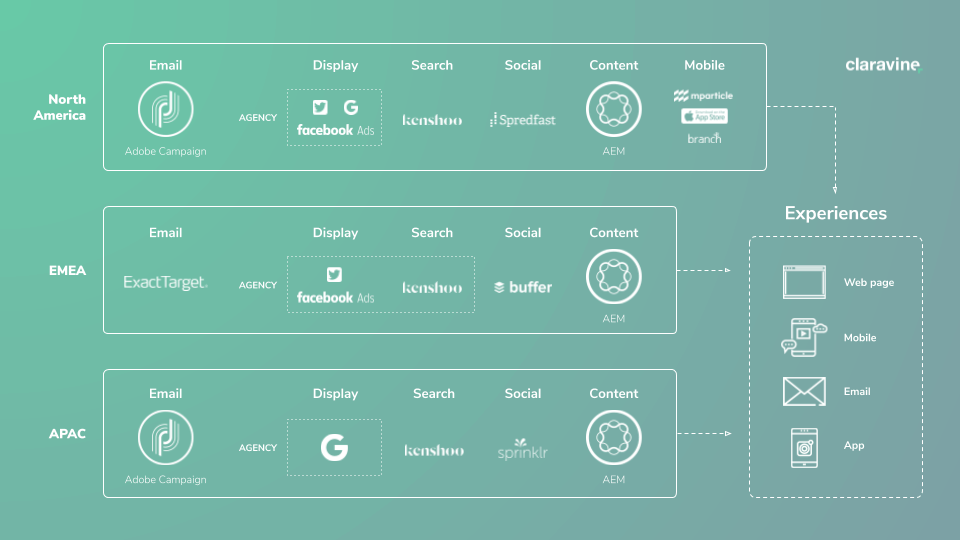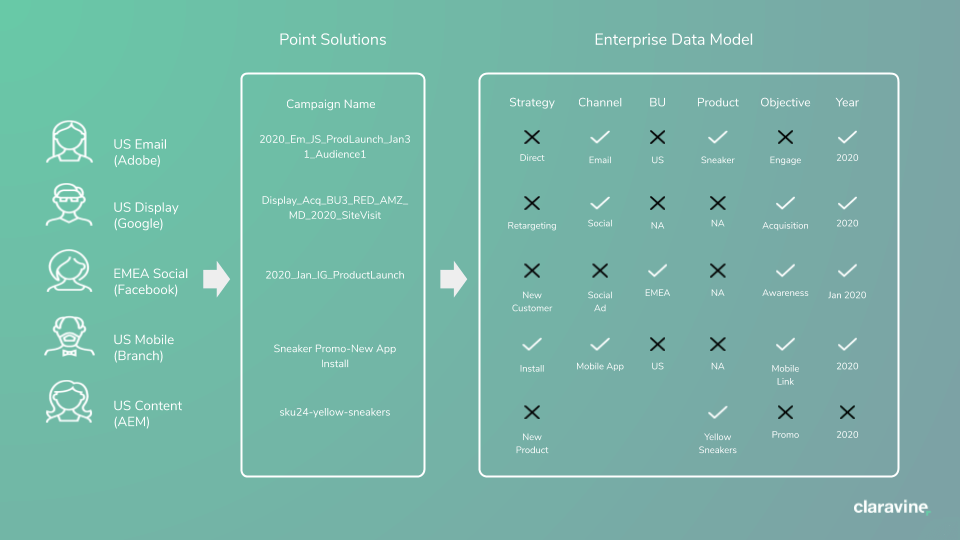How to Build A Business Case For A Unified Marketing Data Management Practice

Bottom Line: Building a business case for consolidating taxonomies to create a unified marketing data management practice is essential for marketing to deliver personalization at scale and accurately measure marketing campaign ROI.
Marketing’s Most Costly Challenge Is Data Consistency
One of the most challenging paradoxes all marketers face today is achieving data consistency across the many diverse areas of a given marketing campaign. Of the many aspects of a successful campaign, the four areas of campaign, content, coupons, and product catalogs have unique metadata definitions that often causes confusion across marketing organizations, stifling marketing strategies from reaching their full potential.
There is lots of other data that needs management and governance: customer data, audience data, first-party data and so on – there is metadata associated to every kind of data record that exists in a marketing organization.
Today, all marketers need to deliver measurable results to keep the budgets they have or to grow them in the future. When there’s no consistency in how metadata elements in campaigns, content, coupons, and catalogs are defined and implemented, marketing’s results are only partially correct. Signs that a marketing department is struggling to get metadata right and needs to consider a unified data marketing governance practice include the following:
- So many conflicting, confusing taxonomies and names that members of the marketing teams have no choice to create new ones for their integrated marketing campaigns in progress.
- What makes matters worse from an accuracy and productivity perspective is the many taxonomies marketing organizations rely on live in spreadsheets scattered across team members’ laptops and in email with no centralized reference point for them.
- A complete definition of each taxonomy and its metadata tags doesn’t exist in a single document, database or software, so the marketing teams are relying on tribal knowledge.
- Multichannel integrated marketing campaigns get launched despite the underlying experience data model not having consistent metadata across every marketing technology orchestrated in the launch.
- Marketing’s efforts to help Sales find new customers and win deals is being slowed down by inconsistent and often incomplete Marketing Analytics regarding campaign performance.
Why Incomplete Experience Data Models Cost So Much
When experience data models have incomplete and inconsistent data, marketers pay the high price of losing their effectiveness to drive more sales and increase their company’s revenues. The bottom line is that incomplete experience data models are among the most costly errors any marketing organization can make. Not only does it force new taxonomies to be created (often on the fly) for new multichannel campaigns, but it also marginalizes how effective marketing can be. Here are a few of the many ways inconsistent experience data models cost so much and reduce marketing effectiveness:
- The high cost of lost time and opportunity trying to launch a multichannel campaign when there are multiple metadata definitions and siloed MarTech systems that aren’t integrated. Lacking a single, unified experience data model with consistent metadata, multichannel marketing strategies will be mediocre at best. The following illustration is an example of what the marketing system architecture often looks like in this scenario.
- When MarTech stacks are duplicated or different across geographies, it is especially challenging to have a single experience data model and consistent metatags due to the regional customer and market differences. When the goal is to deliver a unified multichannel marketing strategy across multiple geographies, most marketing organizations will do their best to collaborate with marketing team peers globally. That’s a great start. It’s clear from the graphic below that if an experience data model existed for all to integrate with, the North American. EMEA and APAC marketing teams would quickly gain greater accuracy, speed, and scale with all three divisions focused on excelling at delivering customer experiences.

- Inconsistent experience data models create more than their share of confusion, starting with no consistency to campaign naming to random metatag definitions and wide gaps that limit marketing’s ability to excel at what they do. The broader the gaps in an experience data model, the less effective marketing is at executing campaigns. Incomplete experience data models caused by a lack of governance make it virtually impossible to quantify the true performance of marketing on any campaign or program. In short, marketing is flying blind and is hoping to track their best performance when they have no way of knowing what that is or how far they need to go to get there.

- Getting integrated marketing campaigns and strategies right has never been more data-dependent, and this is just the beginning. Marketing budgets pivot, rise, or fall on measurable results delivered in previous quarters. Every member of a marketing team knows how measurable of a contribution they make define the future of their departments and careers. When there can be easily over 350 different unique data points to track to deliver an excellent customer experience, marketing’s quantified future becomes clear. Tracking the right experience on the right device and making sure everything is functioning properly, both from a data collection and user experience standpoint, are table stakes for marketing strategy today.
The Many Benefits Of Improving Marketing Data Governance
There’s good news for any marketing leader who has been frustrated with wanting to deliver excellent customer experiences and track progress against their goals. Instead of letting taxonomies that often conflict with each other, confusing metadata tags, and incomplete experience data models stop them, they’re choosing a more effective approach to achieving results.
One of the most effective ways to remove roadblocks to getting more accomplished is to get an existing experience data model in shape if it is incomplete or disjointed. If an experience data model doesn’t exist, the best approach is to define a framework for achieving a unified marketing data governance practice first, then build the model. The following sections explain how this can be done.
First, Get Change Management Right
Marketing organizations succeeding with a unified experience data model got there by making change management a high priority. Simply put, they can get everyone to believe in the need to change and view it as an opportunity to improve, not a threat to their jobs. Getting change management right also means having teams believe in the value of a single, common enterprise taxonomy, making their jobs easier and more productive. Having marketing leaders who can explain why each member of a marketing team is invaluable in the effort to adopt a common enterprise taxonomy is priceless. It can markedly improve marketing competitiveness and results.
When marketing teams believe that data governance is going to free them from the many roadblocks of confusing taxonomies and inconsistent meta tags, everyone accepts the need for automated marketing workflows. The best teams go beyond automating drudgery out of managing experience data models. They give their teams more control over their jobs and workflows than ever before by allowing those to create and own governed processes.
The bottom line is that when marketing teams are given ownership of their jobs and see how vital their contributions are, everyone is more motivated to make every aspect of marketing work. From metadata consistency to experience data models, every marketing team members’ contributions to making them work matters. It’s up to marketing leaders to make their marketing data governance practice make sense in the context of each person’s role. When that happens, marketing data governance can achieve its potential in a marketing organization, delivering the many benefits defined in the next section.
Benefits Of Adopting A Unified Marketing Data Management Practice
When marketing teams see how much easier their jobs are and how much more they can get accomplished when experience data models, metadata, and workflows are stable, additional benefits are possible to achieve. They include the following:
- Achieve greater personalization at scale across all marketing campaigns while ensuring multichannel campaigns improve digital customer experiences by making them consistent across all channels. As was stated earlier, it’s common for multichannel marketing campaigns to rely on 350 different unique data points to track marketing execution and see that every aspect of a marketing campaign is functioning properly. Having an experience data model covering both content creation and marketing campaigns is an essential component to fuel personalization in decision making at scale. The initial review benefit achieved by mid-sized organizations is $20,000 in incremental sales over the first twelve months.
- Create and enforce a single unified taxonomy across all product, marketing, selling, and service groups, improving marketing effectiveness. When marketing teams see the value of adopting a unified marketing data governance practice, the barriers to creating and standardizing on a unified taxonomy across all departments becomes achievable. The time savings alone from better collaboration makes investments in a unified marketing data governance strategy needed in marketing organizations of large-scale enterprises.
- Removing the technical complexities for your marketers by having a common taxonomy they learn and rely on. Simplifying the complex data marketers rely on every day to do their jobs including hundreds of URL structures, macros, and mobile apps dependencies require a standardized framework. By deploying an experience data model based on a standardized taxonomy, marketing teams can save thousands of hours a year in lost productivity. Conservative estimates of saving six full-time employees 60 minutes a week for a year will yield a $75,000 savings assuming each is paid $30/hour or $62,400 a year.
- Unifies campaign and experience tracking across ad solutions, channels, and marketing platforms. Reducing the roadblocks of creating more effective marketing campaigns starts with a taxonomy everyone trusts and can build on. Launching new campaigns and measuring their results accurately becomes easier and more efficient because metadata is consistent across all of them. Optimizing campaigns becomes possible for the first time because common metadata are used to compare results. Conservative estimates of cost savings from reducing overspending on campaigns by having more accurate data is $80,000 a year, at the low-end.
- Consolidate having dozens of systems and multiple taxonomies into a single, unified data governance platform. Intel, at one point, had 26 different systems and 18 different taxonomies across their marketing organizations globally. The high tech manufacturer found it a challenge to create and execute integrated marketing campaigns and measure their effectiveness. Intel broke down their content silos, consolidated their 18 taxonomies down to one corporate-wide, and consolidated their 26 systems down. The result is that today Intel Marketing can precisely define the optimal mix of campaign elements to get measurable results. By reducing the number of licenses on applications and discontinuing maintenance, organizations can save $230,000 from their IT budgets.
- Improve marketing analytics accuracy, measurement, and know why specific marketing campaigns are effective or not. When all marketing teams are aligned on common taxonomy naming conventions and agree to use the standard, analytics accuracy and measurement improve. An example is when marketing teams across an organization collaborate on generating tracking tags and click-through URLs while also validating the landing page tags are working. Using standard naming conventions and tracking codes combined with making sure all of the tags on campaign pages are functioning to pick up data and pass it to the different systems is essential for delivering the right experience. When there’s consistency from the metadata tag level to taxonomies, marketing analytics reflect accurately how every marketing program is performing. It’s possible to see how marketing campaigns contribute to sales because consistent metadata, stable taxonomies, and experience data models reduce the potential for measurement error and incomplete data.
Unified Marketing Data Governance Practice Costs
The costs involved in launching a unified data governance practice include the following:
- Upfront licensing costs for a Marketing Data Management Platform
- Annual Maintenance for the Platform
- Integration and Implementation Costs
- Change Management
- Implementation
- Integration costs increase with the complexity of the data governance solution selected
Creating A Compelling Case For Adopting A Marketing Data Governance Platform
Tangible benefits are the foundation of a compelling business case for an effective unified marketing data governance practice. Quantifying their contributions in quarterly and yearly forecasts, then adding them all up into a single figure, is the first step to creating a successful business case.
The costs associated with launching and supporting a unified marketing data governance practice include but aren’t limited to the following: initial software and services costs to acquire and integrate with the Marketing Data Governance Platform; training and change management costs; launch costs announcing the new platform and its capabilities to the organization and ongoing internal training programs.
The Return on Investment (ROI) for a Data Governance initiative is calculated as follows:
ROI on DG Initiative = (DG Initiative Benefits – DG Initiative Costs)/ DG Initiative Costs x 100.
For a high tech manufacturing company that calculates the annual benefits of a Marketing data governance practice, they can conservatively expect to see $475,000 in benefits for a $150,000 cost, yielding a net return of $3.15 for every $1 invested.
The Return on Investment (ROI) for Data Governance Platform initiative is calculated as follows:
ROI on Data Governance Platform initiative (DG) = (DG Initiative Benefits – DG Initiative Costs)/DG Initiative Costs x 100.
Conclusion
Building a business case to improve marketing performance by standardizing on a single, corporate-wide taxonomy while automating data governance is essential for any marketing organization to make progressively greater contributions to the organization they’re a member of. Having a single, unified taxonomy frees marketing teams to more accurately plan, launch, and track how effective they are at delivering customer experiences that lead to more sales and customer satisfaction. By automating data governance, marketing teams can validate and monitor campaigns, data, and web page readiness to capture results in real-time. Integrating with other enterprise systems to bring greater context into each marketing campaign further increases accuracy and results.
Claravine’s approach orchestrates standardized taxonomies, automates data governance, and integrates data to enable marketing to be more effective with every campaign. ROI for marketing programs increase, and organizations gain new insight and intelligence into how they can adapt to customers’ changing buying preferences in real-time.